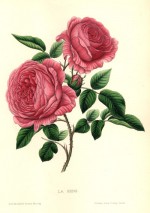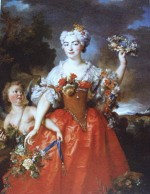 Every year at Valentine’s Day millions of roses are sent to significant others as an expression of love. No other flower comes close to being as popular as the rose, with red roses being the most beloved of all. Although most people would agree that roses are very beautiful flowers, why have roses maintained their esteemed position and not faded in popularity as most fads do?
Every year at Valentine’s Day millions of roses are sent to significant others as an expression of love. No other flower comes close to being as popular as the rose, with red roses being the most beloved of all. Although most people would agree that roses are very beautiful flowers, why have roses maintained their esteemed position and not faded in popularity as most fads do?
The use of roses goes back to ancient Greek and Roman times when they were especially valued for wreaths to honor important events or people. Roses were very special to the Greeks, and Athenian girls that had lost their virginity were not allowed to wear rose wreaths. The Romans were mad about roses too and went so far as to pour warm water on the roots of rose bushes in cool weather to push the roses to bloom. The Roman desire for roses was so great that when they conquered Egypt they made the Egyptians pay tribute in roses and figured out some way of getting the roses to Rome, a 20 day journey, without them dying. Roman mythology assigned two values to roses: purity and innocence represented by white roses, desire and sexual gratification by red. The Roman goddess of Love, Venus, chose the rose as here special flower.

The people of the Middle Ages were heavy into religion and they assigned the rose to the Virgin Mary whom they associated with Venus. The women of the period wore wreaths of flowers including roses on their heads when getting married. As the use of flowers and bouquets for personal adornment grew in the Renaissance the love of roses increased too so that by the 17th century roses were featured in the still life paintings of Flemish artists. By the mid-17th century in the French court of Louis XIV, both men and women carried tussie mussies adorned with lace and ribbons, and in the English court men wore buttonhole bouquets the size of cabbages. In the 18th century the love of mythology portraits further increased the use of roses for personal adornment and by the 19th century the custom of giving tussie mussies according to the language of flowers became the rage with roses playing a dominant role.
The language of flowers was developed to the level of an art, especially in regard to roses. A single rose surrounded by other flowers and foliage could say a great deal about a lovers feelings. The variety, color and stage of development of the rose combined to send a message to the beloved. A cabbage rose was the ambassador of love while the moss rose suggested love and voluptuousness, and a musk rose carried the message of capricious beauty. A red rose still carries the message “I love you” and the feelings of passion, and victory from ancient times, but harmony, joy, charm, luck, and pride may be implied too. A red rosebud implies innocent hope, youth and beauty. The yellow rose can speak of friendship, but also of jealousy, infidelity, decrease of love, or forgive and forget. A white rose may carry a message of suggest silence, keeping a secret, worthiness to be loved, or respect. A white rose bud represents purity and a heart untouched by love, and a withered white rose suggests despair and says that death is preferable to dishonor.
The list of messages that a lover can send with roses is long and can be altered, heightened, or diminished with the inclusion of other plant material. So, for example, if your loved one were on a trip you could send a red rose (passionate love) complemented by lavender (passions of the heart, happiness, devotion), zinnia (thoughts of absent friends), delphinum (return of a friend is desired), bourvardia (enthusiasm) and fern (sincerity).
Most roses this Valentine’s Day will be sent with the single purpose of showing someone special that someone loves them. Most people will send and/or receive red roses as the tradition dictates but some will receive pink or white as preferences are honored. Hopefully, no one will receive yellow roses (unfaithfulness, jealousy), unless it is accompanied by lots of cockscomb (humor).
You can find more Valentine’s Day tips in the previous post: Plants with Special Meanings for Valentine’s Day: Gift Suggestions.
